|
|
|

A Dinosaur with Guts: Italy’s first-ever find comes with something scientists have never seen before – fossilized organs
The Pietraroia limestone beds near Naples, Italy, are celebrated for the exquisite fossils they’ve yielded up since the early 1800s: gorgeously preserved specimens of prehistoric fish and a few birds. No dinosaurs, though. While the rock dates back some 110 million years, smack in the middle of the terrible lizards’ reign, not a single dinosaur bone had ever been found there. As far as amateur palaeontologist Giovanni Todesco knew, that dismal record was still intact even after he unearthed a 23-cm-long specimen about a decade ago. The nearly complete skeleton, missing only its tail and the lower parts of its legs, looked as if it belonged to a bird, and that’s what Todesco assumed it was.
But a couple of years later, he went to see Jurassic Park. As he viewed its distinctly bird-like velociraptors, it suddenly dawned on Todesco that he’d better get a second opinion. Sure enough, when he showed his little critter to experts at a palaeontology museum, it turned out that he had not only the first dinosaur ever found in Pietraroia but the first found anywhere in Italy.
That fact alone made the discovery important. But on close examination, scientists found something even more remarkable: not only had the mini-dino’s bones survived (save those of the lower legs and tail), but so, evidently, had some of the tissues inside. As described in the current issue of the journal Nature, almost certainly a baby, has significant amounts of its intestines and liver still intact, along with muscles and the cartilage that once housed its windpipe – ‘details of soft anatomy never seen previously in any dinosaur,’ write Italian palaeontologists Christiano Dal Sass and Marco Signore.
As a result, the newly named Scipionyx samniticus may end up telling palaeontologists more about the anatomy of theropods – a group of two-legged dinosaurs – than they could ever learn from bones alone. The group, which includes Tyrannosaurus rex as well as velociraptors, is considered by many to comprise the direct ancestors of modern birds. Having the internal organs in hand could help support – or torpedo – that connection. Al-ready, in fact, some scientists are suggesting that the position of the liver indicates an internal structure more like a lizard’s than a bird’s, undercutting the dinosaur-bird link. Its breast-bone, on the other hand, says palaeontologist Mark Norell of the American Museum of Natural History, could hardly be more birdlike.
No matter Scipionyx’s evolutionary significance, its aesthetic significance is clear. ‘It really is a beautiful specimen,’ says Norell. On that, he gets no disagreement from anybody. (Time 6 April 1998) "
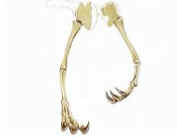
Argeologiese Terrein Nou Oop Vir Toeriste
Thulamela, die argeologiese terrein in die noorde van die Krugerwildtuin, is die naweek vir toeriste oopgestel. Die terrein wat van die tydperk tussen 1200 en 1600 dateer, het die laaste paar jaar groot opgewondenheid onder argeoloŽ veroorsaak toe die oorskotte opgegrawe is van ’n koning en ’n koningin van die gemeenskap wat daar geleef het.
Die breŽ klipmure is tot sowat 1m hoog herbou met die oorblyfsels van die oorspronklike bouwerk wat op die toneel gevind is as riglyn.
Die terrein kan besoek word op ’n begeleide toer van Punda Maria af. Dit duur sowat ses uur, sluit ontbyt aan die oewer van die Levuburivier in en kos R220 per volwassene en halfprys vir kinders. Onbegeleide toere word nie toegelaat nie. (Beeld 22 Junie 1998) "
Geologist Takes Giant Step Onto World Stage (See Word From The President)
Scientists celebrate lucky find of the world’s oldest human footprints
The chance discovery of 100 000-year-old footprints in a calcified sand dune at the Langebaan lagoon north of Cape Town has caused major excitement among local and international scientists.
Two prints, a left and right foot, and a badly eroded third print are believed to have been left behind after a 1,5m-tall woman or male adolescent took a pre-historic stroll down a sand dune – which has long since turned to stone.
The prints were discovered in 1995 by Cape geologist David Roberts, but news of the discovery was made public only this week at an international news conference in Washington following two years of research at the site. A mind-boggling series of lucky circumstances meant the prints were preserved in the sand until the dune finally turned to stone.
‘They would have had to sit in the dune for thousand of years before the dune calcified,’ Roberts said. ‘If the sea level had risen or there’d been an extra-strong wind storm they would’ve been destroyed.’
Roberts found the prints while he was on a solo geological trip to explore ancient sediments around the lagoon for signs that early man had lived there. The discovery follows numerous recent finds along the West Coast, including five-million-year-old fossilised crocodile teeth, skeletal remains of a three-toed horse as well as 200 000-year-old human arte-facts and skeletal remains beneath sand dunes near the Koeberg power station.
The West Coast area contains some of the richest fossil deposits in the world and further research there could yield important evidence about the development of humans and other species. The area first rocketed to fame following the 1953 discovery of ‘Saldanha Man’ – 500 000-year-old human skeletal remains believed to be one of the most significant finds ever.
Roberts said this week that his find had made headlines around the world.
‘The reaction has been overwhelming. The story is on the front pages of all the major newspapers, even the Washington Post. They’re the oldest footprints of anatomically modern man,’ he said. ‘It’s common knowledge that the West Coast is a treasure trove of archaeological material. It’s absolutely astounding how much is being found.’
The Langebaan prints have given scientists a remarkable insight into the gait and foot size of early man. Local scientists said the find entrenches the West Coast as one of the world’s leading archaeological sites. (Sunday Times 17 August 1997)
A Lost ‘Living Fossil’, Rediscovered in Madagascar, Could be the Link in the Evolution of Flowering Plants
A single specimen of the tree Takhtajania perrieri was discovered in the northwest of the island in 1909, but numerous attempts to find more specimens in the same area drew a blank, and the species appeared to be lost to science. Now, however, botanists have located a thriving population of about 50 trees in the Anjahanaribe-Sub Special Reserve, on the other side of the island from the original discovery.
‘It’s a very exciting find,’ says George Schatz of the Missouri Botanical Gardens in St Louis, who identified the specimens. ‘The tree belongs to the family Winteraceae, which contains some of the most primitive flowering plants. Plants belonging to this family disappeared from mainland Africa roughly 24 million years ago.’
Schatz believes the wide range of habitats on the mountainous island may have protected it from the periods of severe drought that wiped out primitive flowering plans elsewhere in Africa.
T. perrieri grows 7 metres tall, and its crimson flowers are thought to bloom each May. It has a combination of advanced and primitive features. Early flowering plants contained many individual carpels, or seed envelopes, says Schatz, whereas in advanced plants the carpels are fused into a compound structure. ‘Takhtajania could be one of the first examples of a flowering plant developing a compound carpel,’ he says. (New Scientist 2 August 1997) "
Move Over, T Rex, Because Africa Has the New King of the Dinosaurs
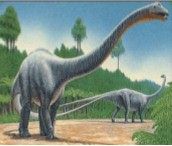
CHICAGO – Paul Sereno examines the giant jawbone in his laboratory, rubbing his fingers across its shark-like teeth, and describes how he and a group of palaeontology students discovered the remains of the largest meat-eating dinosaur to ever walk the earth.
His team of eight men and one woman from the University of Chicago had spent 40 days trekking through the desert of Western Morocco. Each was losing close on half a kilogram a day in the searing heat. They were following the trail of an ancient river bed, picking up small bones and following a few footprints. They had come up empty-handed, when suddenly their persistence paid off.
‘I was scaling the cliffs some 150m up, almost beside myself with joy and picking out of the ground a beautiful chunk of the back end of the skull,’ says Sereno, who has the exuberance and good looks of the movie character Indiana Jones. ‘In a few seconds, I knew it was a predatory dinosaur. I could see the teeth going into the side of the cliff.’
The discovery of Carcharo-dontosaurus saharicus, a vicious shark-toothed reptile from the Sahara, is the talk of the palaeontology world. The monster dominated most of Africa 90 million years ago, slicing its prey with its giant jawbones and gulping it down like a giant shark.
‘They ripped with their jaws and had very strong necks,’ says Sereno, looking at a full-scale replica of the beast displayed in a library near his office. ‘I think it was an "ambush" predator. It would lie in wait and would dismember something rather quickly.’
While Tyrannosaurus rex roamed North America 65 million years ago, Carcharo-dontosaurus ruled over Africa. ‘We were able to identify its teeth in Tunisia, Egypt and ZaÔre,’ says Sereno, who first published his findings last year in the prestigious journal Science.
The discovery has put the spotlight on Sereno himself. The wiry scientist is a star at scientific meetings and at the age of 39, he has already led expeditions to South America, China and Africa. He says the 1995 trip to Morocco was the toughest trip of all.
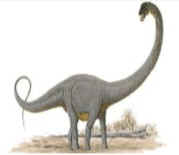
Sereno followed the trail of the French explorers who first discovered a few bones of Carcharodontosaurus six decades ago. The bones they recovered were destroyed in Germany during the war, so he had only a few notes describing the expedition. Carcharo-dontosaurus represents one of the most significant discoveries in palaeontology. It appears to be even larger than T. rex, once thought of as the king of the beasts. Now palaeontologists such as Sereno are ready to name Carcharodontosaurus the new king.
The beast’s narrow-snouted skull measures more than 1,5m long. ‘It has a very birdlike skull, probably edging out Tyrannosaurus in length,’ Sereno says. ‘The neck is the neck of an American football player. It’s just remarkable. This animal had a very stocky build.’
Based on its bone structure, Sereno estimates the animal probably weighed 7 to 8 tons. It was about 15m in length but, remarkably, its brain – based on new studies – could fit into a soft-drink can.
‘It doesn’t really require a lot of brain power and neuro mass to actually go about terrorizing the largest animals of the day, and Carcharo-dontosaurus was capable of doing this with a brain that would have easily fitted in the palm of your hand,’ Sereno says. (The Star 12 April 1997)
* See Profiel / Profile: "A Portrait of Dr Paul Sereno – the ‘Suchomimus Star’ " (Steve Brusatte)
New Species of Dinosaur Found
Fossils discovered in western New Mexico are believed to be from the oldest horned dinosaurs ever found and could help fill in a 15-to-20-million-year gap in the lives and times of dinosaurs in North America. The new species of dinosaur lived about 90 million years ago.
An Arizona museum curator and his 7-year-old son found a brow horn from a ceratopsian, or horned dinosaur, last year near Quemado in western New Mexico. That find and others from the desert site were announced in Phoenix, Arizona, last month.
The earliest-known dinosaurs appeared prior to about 200 million years ago, but palaeontologists believe the fossils could fill in missing data from later periods. – Reuters (The Star 23 August 1997) "
Dino-spoor Teruggekry
'n Gesteelde dinosourus-voetspoor wat na bewering vir die internasionale sluikhandel bestem was, is naby rotse in Wes-AustraliŽ waaruit dit gesny is, deur die polisie opgespoor.
Die voetafdruk, glo sowat 120 miljoen jaar oud, lÍ in 'n stuk rots so groot soos ’n aktetas. Twee mans is aangekla na die diefstal van die voetspoor op ’n heilige terrein. ‘Ons weet daar was pogings om dit in AsiŽ te verkoop,’ sÍ sers. Geoff Fuller van die polisie op Broome.
Die volstruisagtige voetspoor, vermoedelik diť van ’n soort reptiel wat op die vroegste voŽls jag gemaak het, is nou in polisie besit, maar 'n stel seldsame menslike voetspore van omtrent 7 000 jaar oud wat ook verlede jaar gesteel is, word steeds vermis.
Die spoor van 'n stegosourus is drie jaar gelede op 'n ander heilige terrein uitgesny. Sover bekend is dit die enigste stegosourus-voetafdruk ter wÍreld en die enigste bewys dat die reptiele eens in AustraliŽ voorgekom het.
Na berig word, is die voetafdrukke van die dinosourus by Crab Creek en die menslike voetspore by Lombadina met 'n hoekslyper uitgesny. (Rapport 10 Januarie 1999) "
New Name for Fossil Museum
The little boy who became a diesel mechanic who became a world famous scientist will now have his name joined forever with his beloved Bernard Price Institute for Palaeontological Research in the ‘James Kitching Gallery’.
Here, South Africans of all ages will be able to see and feel worlds long gone: the prehistoric world of strange and fascinating life forms, and the scientific world of James Kitching, Robert Broom and Raymond Dart.
Prof Kitching and his friend Fred (Tapinocaninus) were a distinguished pair at the University of the Witwatersrand function for the renaming of the fossil museum to the ‘James Kitching Gallery’. (The Citizen 12 August 1998) "
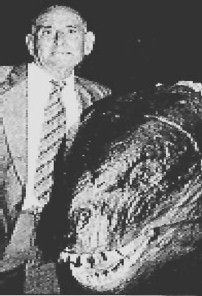
Professor James Kitching and his friend Fred
Dinosaur Garden Found
BEIJING – The world’s largest habitat of a giant fern dating to the age of the dinosaurs 100 million years ago has been found in a remote area of south-west China’s Yunnan province. The Cyathea spinulosa can grow 10m high. The ‘habitat that time forgot’ covers more than 10ha in a natural reserve. – AFP (Saturday Star 5 July 1997) "
Rich New Hominid Site Discovered - by Ellen Bartlett
The question that probably will never be answered is how the bodies of 2 children ended up in a cave on the farm called ‘Drimolen.’* Perhaps they died there of cold, disease, starvation. Perhaps they died nearby, and their bodies were washed in by the rains, or was carried in in the mouth of a carnivore – a brown hyena, or sabre-toothed cat.
The first child passed away at about 3 years of age, perhaps as young as 2. At the time of death, he, or she, was probably teething. The second died in early infancy, at an age no more than about 8 to 10 months. However, they ended up in the cave, and they lay there for 1,5 to 2 million years, slowly becoming entombed in soil and rock, until they were unearthed earlier this year by a research team excavating the site.
The elder of the 2 children is being described as a member of the genus Homo, the line that led to modern humans; the infant is described as Paranthropus robustus (also known as Australopithecus robustus), one of the small-brained, vegetarian ape-people that went extinct about a million years ago.
The 2 were found, not far from one another, in a block of cave sediment at a depth of 4,2m in remarkably good repair for all their years underground. Andre Keyser, director of the excavation at Drimolen, one of South Africa’s newest and most promising hominid fossil sites, announced the discovery at a press conference earlier this week in Paris.
The fossils are important, Keyser said in an earlier interview at the site, because of their age – both their antiquity, dating from the Plio-Pleistocene era, and the tender years of the children – and because of the fossils’ relative completeness and good state of repair.
They secure Drimolen’s place as one of the richest hominid fossil sites in South Africa – only the long-excavated sites of Sterkfontein and Swartkrans have produced more prehuman and early human fossils.
The remains of the first early human child include the lower jaw with 2 baby teeth and the child’s first permanent molar – which had not yet erupted and was still pushing its way through the child’s gum. Next to the jaw were the bones of the child’s forearm, the radius and ulna. Pieces of the child’s skull, say some of the scientists involved, may be enough to calculate the size of the child’s brain.
The remains of the second child, found a few weeks after the first, consist of both maxillae – the 2 halves of the child’s upper jaw, 2 baby milk teeth, and the frontal bone of the child’s skull. The state of development of the teeth indicate it was a tiny baby, probably the youngest in years of any early hominid found. The 2 sets of bones have both been estimated at 1,5 to 2 million years old.
Phillip Tobias, retired head of the Palaeoanthropology Research Unit at the University of the Witwatersrand, called the fossils ‘miraculous discoveries’ and complimented Keyser’s skill in ‘bringing to light two specimens whose teeth are not fully developed, whose skull bone is eggshell thin’.
Wrapped in tissue, the entire fragile assemblage of bits and fragments fits into a margarine container. ‘This is the Paranthropus baby,’ Keyser said. ‘You’re looking into its eyes.’ More accurately, one could look into where the eyes would have been, under the arched frontal bone. ‘Though it was probably no more than 8 months of age when it died, its development was equivalent to a human baby of 11 to 14 months,’ he said. ‘One wonders what tragedy led to the death of this lovely little baby.’
The remains of these early human are more complete than most; scientists are particularly excited about finding the bones of the arm – post-cranial bones are rare in hominid fossils. The results may settle a long-standing debate about whether the traits used to identify adults can also be found in infants. And in so doing, they promise to put to rest the old debate about whether the Taung child, South Africa’s first and most famous fossil, was a robust or gracile australo-pithecine youngster. It has been speculated that the Taung child was not, in fact, Australo-pithecine africanus, but a young Paranthropus whose robust characteristics had not yet developed at the age the child died.
But the frontal bone of the Drimolen infant is clearly identifiable as Paranthropus by its thin brow ridges and by the slight depression at the glabella, the point where the eyebrows meet.
There is much work to be done on the fossil babies – faunal dating is still in progress. And excavation at Drimolen is equally in its infancy. Researchers are still digging trenches, to try to determine where the cave system begins and ends. (Condensed: Mail & Guardian ‘Frontiers’, 19 December 1997)
TOPWits Wys Fossiel van Skedel uit Noord-Kaap
Die navorsingspan van die Universiteit van die Witwatersrand (Wits) het gister ’n fossiel van ’n skedel bekend gestel wat die idee ondersteun dat alle soogdiere hul oorsprong in Suid-Afrika gehad het.
Die Anomocephalus africans was ’n kruising tussen ’n soogdier en ’n reptiel. Dit was min of meer so groot soos ’n skaap en het 260 miljoen jaar gelede in die Karoo aan die oewer van ’n binnelandse see geleef. Die Karoo was in diť tydperk vermoedelik boomryk en het deel gevorm van die prehistoriese oer-kontinent Gondwana. Die Anomocephalus africans sou onder meer gelewe het van plante.
Diť dier is deel van die anomodonts-groep wat in die Permian-tydperk lank voor die dinosourusse gelewe het. Die mees algemene diersoort in die Permian-tydperk was so groot soos ’n haas en het ’n soort-gelyke ekologiese rol gehad as wat vandag se knaagdiere het.
‘Ons het die skedel ontdek op ’n besoek van twee weke aan Williston in die Noord-Kaap in 1995,’ het prof. Bruce Rubidge, direkteur van die Bernard Price-instituut vir paleo-antropologiese navorsing by Wits, gesÍ.
‘Dit was 'n groot verassing. Ek werk al 26 jaar lank om sů iets te kry. Soms werk jy die hele dag in die son en kry niks,’ het mnr John Nyaphuli van die Nasionale Museum in Bloemfontein gesÍ. Hy het op die skedel afgekom nadat die navorsingspan in groepe verdeel het om die rotsformasies in die omgewing te bestudeer.
‘Die skedel is byna ongeskonde, net die voorste deel van die neus is ietwat verweer,’ het dr Sean Modesto, ’n navorser van Kanada, gesÍ. ‘Die tande dui daarop dat dit ’n herbivoor moes gewees het.’
Die fossiele van soortgelyke diere wat in Rusland gevind is, is waarskynlik die nasate van die fossiel wat in die Karoo gevind is. (Beeld 12 Maart 1999) "
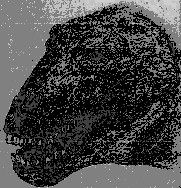
Anomocephalus africans
TOPPaleontoloog Kry Eredoktoraat op UP se Herfsplegtigheid
’n WÍreldbekende paleontoloog is vanjaar die enigste mens wat tydens die herfsgradeplegtighede van die Universiteit van Pretoria (UP) met ’n eredoktoraat vereer word. Dr Charles Kimberlin (Bob) Brain word beskou as een van Suid-Afrika se briljantste wetenskaplikes, iemand wat wÍreldwyd erkenning op die gebied van paleontologie verwerf het. Die eredoktoraat word deur die fakulteit biologiese en landbouwetenskappe van die UP aan hom toegeken.
Brain is in 1931 in Zimbabwe gebore. Hy het in 1947 aan die Pretoria Boys’ High School gematrikuleer, waarna hy sy studie aan die Universiteit van Kaapstad begin het. Hy het in 1957 sy doktorsgraad in paleontologie daar verwerf.
Hy het onder meer as geoloog by die WNNR gewerk. Van 1954 tot 1960 was hy navorser by en kurator van die Transvaal-museum. In 1961 het hy na Zimbabwe verhuis waar hy adjunkdirekteur van die nasionale museums van Zimbabwe geword het. In 1965 het hy na die Transvaal-museum teruggekeer – eers as kurator van paleontologie tot 1968 en daarna as direkteur tot 1991. Brain is daarna as kurator van ongewerweldes aangewys. Hy het in 1996 afgetree.
Brain het talle nasionale toekennings vir sy navorsing ontvang. Sy navorsing is in 3 boeke en 168 wetenskaplike artikels gepubliseer. Brain het in 1991 ’n eredoktoraat van die Universiteit van Kaapstad ontvang asook ’n eredoktoraat van die Universiteit van Natal in 1993. (Gekondenseerd: Beeld 15 April 1999) "
TOPDiť Voetspore is 200 000 Jaar Oud
OOS-LONDEN. – Versteende voetspore* wat reeds in 1964 toevallig naby Nahoon ontdek is, het Vrydag amptelik die oudste versteende ‘menslike’ voetspore geword toe wetenskaplike toetsresultate die ouderdom van die spore as 200 000 jaar oud gesertifiseer het. Diť uitslag bewys onomwonde dat die Nahoon-spore etlike duisende jaar ouer is as die bekende spore by Langebaan wat in 1995 ontdek is.
Volgens die geoloog wat die toetse op die spore uitgevoer het, dr David Roberts, is die spore ’n belangrike skakel in die verstaan van menslike evolusie en vorm dit saam met ander spore in Afrika ’n belangrike patroon van evolusie.
Die spore is destyds ontdek deur twee munisipale werkers wat die vloei van rioolwater moes bepaal. Kort nadat die twee werkers onder ’n oorhang skuiling teen die son gesoek het, het hulle die eienaardige merke gesien en dit onmiddelik by die plaaslike museum aangemeld.
Volgens Roberts is die spore diť van ’n kleinerige, moontlik jong wese. Saam met die voetspore is daar ook poot- of hoefmerke van’n dier en merke wat moontlik deur’n voŽl gemaak is. Hy het voorts gesÍ hy glo daar is meer spore in die onmiddelike omgewing omdat dit onwaarskynlik is dat 'n kind of ’n jong mens alleen langs die onherbergsame kus sou wandel.
Roberts het ook in 1995 die Langebaan-spore ontdek van ’n anatomies moderne mens wat 117 000 jaar oud is. Die spore by Nahoon is van ’n argaÔese, anatomies moderne mens en is meer as 80 000 jaar ouer as die Langebaan-spore. Die tydperk waarin die Nahoon- en Langebaan-spore getrap is, is ’n tydperk waarvan paleontoloŽ min weet.
Net vier stelle ‘menslike’ spore is al gevind, en die ander twee stelle in TanzaniŽ en Kenia is ouer as die Suid-Afrikaanse spore, maar is getrap deur aapagtige wesens wat aan die begin van die evolusieproses gestaan het. (Beeld 11 November 1998)
Sien Word from the President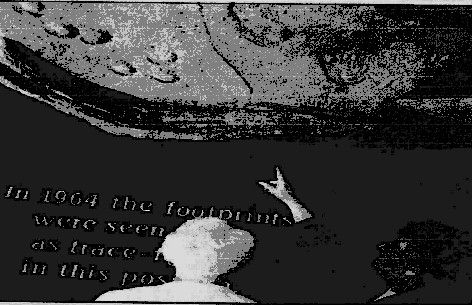
Gorgon Fossil is a Rare Find
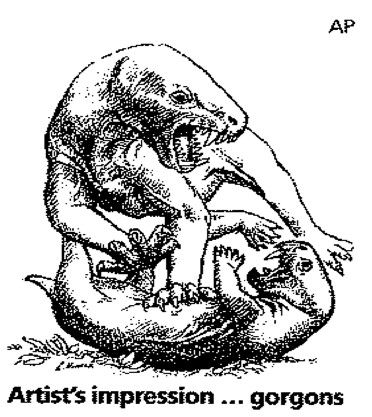
SEATTLE – Peter Ward and Roger Smith weren’t looking for a gorgon, but that’s what they found – what’s believed to be the only complete fossil of one of the fiercest animals of prehistory. ‘Think of the biggest, most ferocious lion you can imagine, but with lizard skin,’ said Ward, a University of Washington paleontologist.
The gorgon – formally called gorgonopsid – was a mammal-like reptile that lived 250 million years ago, before the age of dinosaurs. It was named after the beast of Greek mythology whose gaze would turn anyone looking at it into stone. Anything that looked at a gorgon would be lucky not to turn into lunch.
Gorgons were the largest predators of the late Palaeozoic era. Some weighed as much as 360 kg, though others were small as house cats. They were the first sabre-toothed animals.
‘These things were really well-adapted killing machines,’ said James Hopson, a University of Chicago expert on the creatures. ‘They had blade-like, serrated teeth that could go through flesh like a warm knife through butter.’
Ward and Smith, a paleontologist at the South African Museum in Cape Town, made their discovery several weeks ago in the Karoo, a region known for its fossil troves. ‘This appears to be a very complete, enormous skeleton,’ Hopson said. – Sapa-AP (The Star 9 December 1998) "